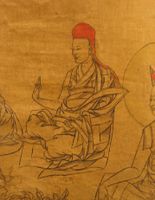Difference between revisions of "ShAkya mchog ldan"
Jump to navigation
Jump to search
| Line 1: | Line 1: | ||
{{Person | {{Person | ||
| − | |||
| − | |||
| − | |||
|HasDrlPage=Yes | |HasDrlPage=Yes | ||
|HasLibPage=No | |HasLibPage=No | ||
| Line 8: | Line 5: | ||
|HasDnzPage=No | |HasDnzPage=No | ||
|HasBnwPage=Yes | |HasBnwPage=Yes | ||
| + | |pagename=ShAkya mchog ldan | ||
| + | |PersonType=Classical Tibetan Authors | ||
| + | |images=File:Shakya Chokden.jpg{{!}}[https://www.himalayanart.org/items/65562/images/65562k#-992,-1600,2191,0 Himalayan Art Resources] | ||
|MainNamePhon=Śākya Chokden | |MainNamePhon=Śākya Chokden | ||
| + | |SortName=Shākya Chokden | ||
|MainNameTib=ཤཱཀྱ་མཆོག་ལྡན་ | |MainNameTib=ཤཱཀྱ་མཆོག་ལྡན་ | ||
|MainNameWylie=shAkya mchog ldan | |MainNameWylie=shAkya mchog ldan | ||
Revision as of 12:43, 9 September 2020
ཤཱཀྱ་མཆོག་ལྡན་
| Wylie | shAkya mchog ldan |
|---|---|
| English Phonetics | Śākya Chokden |
| Sort Name | Shākya Chokden |
Dates
| Birth: | 1428 |
|---|---|
| Death: | 1507 |
| Place of birth: | gsang mda' bang rim |
Tibetan calendar dates
| Day | |
|---|---|
| Month | |
| Gender | Male |
| Element | Earth |
| Animal | Monkey |
| Rab Jyung | 7 |
About
- Religious Affiliation
- Sakya
- Primary Professional Affiliation
- Sangpu Neutok
- Teachers
- rong ston shes bya kun rig · don yod dpal ba · Ngor mkhan chen, 1st · spyang lung chos sdings gzhon nu blo gros
Other Biographical info:
Links
- BDRC Link
- https://www.tbrc.org/#!rid=P396
- Treasury of Lives Link
- https://treasuryoflives.org/biographies/view/%C5%9A%C4%81kya-Chokden/6351
- Wiki Pages
Buddha Nature Project
- Person description or short bio
Expand to see this person's philosophical positions on Buddha-nature.
| Is Buddha-nature considered definitive or provisional? | |
|---|---|
| Position: | Definitive |
| Notes: | Though his unique presentation allows for both definitive and provisional versions of buddha-nature. The distinction between the two depends on whether there is direct experience of the unstained buddha-nature and its corresponding qualities, or, alternatively whether this nature is latently present in an obscured form. |
| All beings have Buddha-nature | |
| Position: | Qualified No |
| If "Qualified", explain: | All beings possess a "nominal" buddha-nature as is taught in the second-wheel teachings, while only bodhisattvas on the first bhumi and up (i.e. Noble Bodhisattvas) possess the "actual" buddha-nature as it was taught in the third-wheel teachings. (see note from Brunnhölzl below) |
| Notes: | #"Though everyone including ordinary beings possesses wisdom in a nonmanifest manner, only bodhisattvas on the first bhūmi onward manifest this wisdom as the direct realization of ultimate reality. This means that only such bodhisattvas possess the actual tathāgata heart in that they see at least certain degrees of purification of the stains that cover the tathāgata heart as well as its inseparability from certain degrees of buddha qualities. Ordinary beings thus do not possess this actual tathāgata heart at all, while buddhas possess it in its completeness. In other words, the close connection between seeing the tathāgata heart free from adventitious stains and possessing it, as well as between becoming free from adventitious stains and “attaining” the qualities of a buddha, is a prominent feature of Śākya Chogden’s interpretation of tathāgatagarbha." Brunnhölzl, K., When the Clouds Part, p. 78.
|
| Which Wheel Turning | |
| Position: | Third Turning |
| Notes: | He distinguishes between different types of buddha-nature taught in the second and third wheels, though the third is the more definitive and represents the "actual" tathāgatagarbha. |
| Yogācāra vs Madhyamaka | |
| Position: | Madhyamaka |
| Notes: | |
| Zhentong vs Rangtong | |
| Position: | |
| Notes: | |
| Promotes how many vehicles? | |
| Position: | |
| Notes: | |
| Analytic vs Meditative Tradition | |
| Position: | |
| Notes: | |
| What is Buddha-nature? | |
| Position: | There are several types of Tathāgatagarbha |
| Notes: | #"In sum, Śākya Chogden distinguishes three kinds of tathāgata hearts: (1) the nominal tathāgata heart that is the mere natural purity (as taught in the second dharma wheel and its Madhyamaka commentaries), (2) the actual tathāgata heart that is the purity of adventitious stains and represents the relative tathāgata heart (as taught in the third dharma wheel and the Nonaspectarian system of Maitreya and Asaṅga, as well as in the teachings of expedient meaning in the second dharma wheel as these are interpreted by the third dharma wheel), and (3) the actual tathāgata heart that is the natural purity that is inseparable from all buddha qualities and represents the ultimate tathāgata heart (as taught in the system of Maitreya and Asaṅga and in the third dharma wheel)." Brunnhölzl, K., When the Clouds Part, p. 78.
|
| Svātantrika (རང་རྒྱུད་) vs Prāsaṅgika (ཐལ་འགྱུར་པ་) | |
| Position: | |
| Notes: | |
| Causal nature of the vajrapāda | |
| Position: | |
